2A.eco - Traitement automatique de la langue en Python - correction#
Links: notebook, html, python, slides, GitHub
Correction d’exercices liés au traitement automatique du langage naturel.
from jyquickhelper import add_notebook_menu
add_notebook_menu()
On télécharge les données textuelles nécessaires pour le package nltk.
import nltk
nltk.download('stopwords')
[nltk_data] Downloading package stopwords to [nltk_data] C:UsersxavieAppDataRoamingnltk_data... [nltk_data] Package stopwords is already up-to-date!
True
Exercice 1#
corpus = {
'a' : "Mr. Green killed Colonel Mustard in the study with the candlestick. "
"Mr. Green is not a very nice fellow.",
'b' : "Professor Plum has a green plant in his study.",
'c' : "Miss Scarlett watered Professor Plum's green plant while he was away "
"from his office last week."
}
terms = {
'a' : [ i.lower() for i in corpus['a'].split() ],
'b' : [ i.lower() for i in corpus['b'].split() ],
'c' : [ i.lower() for i in corpus['c'].split() ]
}
from math import log
QUERY_TERMS = ['green', 'plant']
def tf(term, doc, normalize=True):
doc = doc.lower().split()
if normalize:
return doc.count(term.lower()) / float(len(doc))
else:
return doc.count(term.lower()) / 1.0
def idf(term, corpus):
num_texts_with_term = len([True for text in corpus if term.lower()
in text.lower().split()])
try:
return 1.0 + log(float(len(corpus)) / num_texts_with_term)
except ZeroDivisionError:
return 1.0
def tf_idf(term, doc, corpus):
return tf(term, doc) * idf(term, corpus)
query_scores = {'a': 0, 'b': 0, 'c': 0}
for term in [t.lower() for t in QUERY_TERMS]:
for doc in sorted(corpus):
score = tf_idf(term, corpus[doc], corpus.values())
query_scores[doc] += score
print("Score TF-IDF total pour le terme '{}'".format(' '.join(QUERY_TERMS), ))
for (doc, score) in sorted(query_scores.items()):
print(doc, score)
Score TF-IDF total pour le terme 'green plant'
a 0.10526315789473684
b 0.26727390090090714
c 0.1503415692567603
Deux documents possibles : b ou c (a ne contient pas le mot “plant”). B est plus court : donc green plant “pèse” plus.
QUERY_TERMS = ['plant', 'green']
query_scores = {'a': 0, 'b': 0, 'c': 0}
for term in [t.lower() for t in QUERY_TERMS]:
for doc in sorted(corpus):
score = tf_idf(term, corpus[doc], corpus.values())
query_scores[doc] += score
print("Score TF-IDF total pour le terme '{}'".format(' '.join(QUERY_TERMS), ))
for (doc, score) in sorted(query_scores.items()):
print(doc, score)
Score TF-IDF total pour le terme 'plant green'
a 0.10526315789473684
b 0.26727390090090714
c 0.1503415692567603
Le score TF-IDF ne tient pas compte de l’ordre des mots. Approche “bag of words”.
QUERY_TERMS = ['green']
term = [t.lower() for t in QUERY_TERMS]
term = 'green'
query_scores = {'a': 0, 'b': 0, 'c': 0}
for doc in sorted(corpus):
score = tf_idf(term, corpus[doc], corpus.values())
query_scores[doc] += score
print("Score TF-IDF total pour le terme '{}'".format(term))
for (doc, score) in sorted(query_scores.items()):
print(doc, score)
Score TF-IDF total pour le terme 'green'
a 0.10526315789473684
b 0.1111111111111111
c 0.0625
len(corpus['b'])/len(corpus['a'])
0.4423076923076923
Scores proches entre a et b. a contient deux fois ‘green’, mais b est plus de deux fois plus court, donc le score est plus élevé. Il existe d’autres variantes de tf-idf. Il faut choisir celui qui correspond le mieux à vos besoins.
Exercice 2#
Elections américaines#
import json
import nltk
USER_ID = '107033731246200681024'
with open('./ressources_googleplus/' + USER_ID + '.json', 'r') as f:
activity_results=json.load(f)
all_content = " ".join([ a['object']['content'] for a in activity_results ])
tokens = all_content.split()
text = nltk.Text(tokens)
text.concordance('Hillary')
Displaying 2 of 2 matches:
fund a Get Out The Vote effort for Hillary in Pennsylvania. There's a transit
will pay for rides to the polls for Hillary voters via Uber and Lyft. I just su
text.concordance('Trump')
Displaying 3 of 3 matches:
is made me laugh out loud. One thing Trump has been good for is the rise of col
, its funding is under attack by the Trump administration. This is the infrastr
g." I dreamed last night that Donald Trump was taking people on a tour through
text.concordance('vote')
Displaying 7 of 7 matches:
the first time bucked management to vote in favor of a climate-risk resolutio
Boot Camp on the way in. My Ride To Vote has created a crowdfunding campaign
nding campaign to fund a Get Out The Vote effort for Hillary in Pennsylvania.
didates and which contacts might not vote on election day. Next, we provide yo
y http://oreil.ly/2f54ypw Start-Up & Vote is a movement to encourage tech comm
ent to encourage tech communities to vote early and vote together. Get a group
e tech communities to vote early and vote together. Get a group together for y
text.concordance('politics')
Displaying 3 of 3 matches:
ext for the current state of world politics and what I've been calling the #WT
ge the way you think about today's politics as well. I am so glad that Russ Ro
pears to be a deeper dive into the politics of top billionaires. In this time
fdist = text.vocab()
fdist['Hillary'], fdist['Trump'], fdist['vote'], fdist['politics']
(2, 3, 4, 3)
Loi Zipf#
%matplotlib inline
fdist = text.vocab()
no_stopwords = [(k,v) for (k,v) in fdist.items() if k.lower() \
not in nltk.corpus.stopwords.words('english')]
#nltk a été porté en python récemment, quelques fonctionnalités se sont perdues
#(par exemple, Freq Dist n'est pas toujours ordonné par ordre décroissant)
#fdist_no_stopwords = nltk.FreqDist(no_stopwords)
#fdist_no_stopwords.plot(100, cumulative = True)
#le plus rapide : passer par pandas
import pandas as p
df_nostopwords = p.Series(dict(no_stopwords))
df_nostopwords.sort_values(ascending=False)
df_nostopwords.plot();
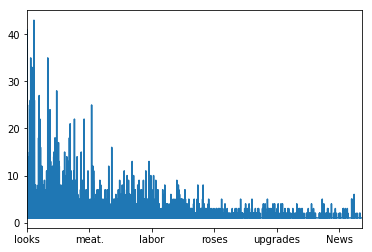
import matplotlib.pyplot as plt
df_nostopwords=p.Series(dict(no_stopwords))
df_nostopwords.sort_values(ascending=False)
df_nostopwords=p.DataFrame(df_nostopwords)
df_nostopwords.rename(columns={0:'count'},inplace=True)
df_nostopwords['one']=1
df_nostopwords['rank']=df_nostopwords['one'].cumsum()
df_nostopwords['zipf_law']=df_nostopwords['count'].iloc[0]/df_nostopwords['rank']
df_nostopwords=df_nostopwords[1:]
plt.plot(df_nostopwords['count'],df_nostopwords['zipf_law'], '.');
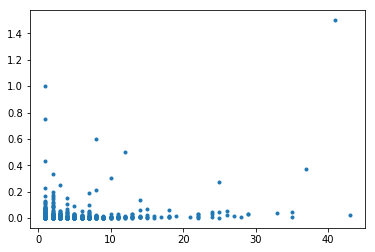
df = p.Series(fdist)
df.sort_values(ascending=False)
df.plot();
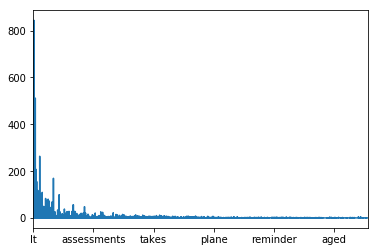
df = p.Series(fdist)
df.sort_values(ascending=False)
df=p.DataFrame(df)
df.rename(columns={0:'count'},inplace=True)
df['one']=1
df['rank']=df['one'].cumsum()
df['zipf_law']=df['count'].iloc[0]/df['rank']
df=df[1:]
fig, ax = plt.subplots(1, 1)
ax.plot(df['count'], df['zipf_law'], '.')
ax.set_title("zipf_law");
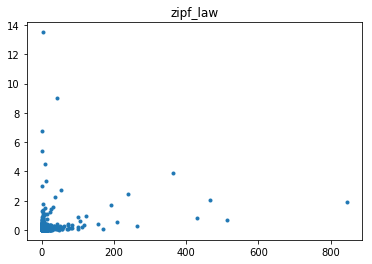
Diversité du vocabulaire#
def lexical_diversity(token_list):
return len(token_list) / len(set(token_list))
USER_ID = '107033731246200681024'
with open('./ressources_googleplus/' + USER_ID + '.json', 'r') as f:
activity_results=json.load(f)
all_content = " ".join([ a['object']['content'] for a in activity_results ])
tokens = all_content.split()
text = nltk.Text(tokens)
lexical_diversity(tokens)
3.075705808307858
Exercice 3#
3-1 Autres termes de recherche#
import json
import nltk
path = 'ressources_googleplus/107033731246200681024.json'
text_data = json.loads(open(path).read())
QUERY_TERMS = ['open','data']
activities = [activity['object']['content'].lower().split() \
for activity in text_data \
if activity['object']['content'] != ""]
# Le package TextCollection contient un module tf-idf
tc = nltk.TextCollection(activities)
relevant_activities = []
for idx in range(len(activities)):
score = 0
for term in [t.lower() for t in QUERY_TERMS]:
score += tc.tf_idf(term, activities[idx])
if score > 0:
relevant_activities.append({'score': score, 'title': text_data[idx]['title'],
'url': text_data[idx]['url']})
# Tri par score et présentation des résultats
relevant_activities = sorted(relevant_activities,
key=lambda p: p['score'], reverse=True)
c=0
for activity in relevant_activities:
if c < 6:
print(activity['title'])
print('\tLink: {}'.format(activity['url']))
print('\tScore: {}'.format(activity['score']))
c+=1
This is a really important piece about open data and platforms.
Link: https://plus.google.com/+TimOReilly/posts/fo9uxWTctHb
Score: 0.5498599632119789
I love new sources of trend data about technology adoption. We've used variations of this for years ...
Link: https://plus.google.com/+TimOReilly/posts/FetXVRJeJFv
Score: 0.17368671875174563
If you love Hamilton, as I do, and you're interested in data visualization, you'll find this fascinating...
Link: https://plus.google.com/+TimOReilly/posts/NNsiSo8K7B7
Score: 0.16687547487912816
Data can play a great role in advancing sustainability. I'm quoted in this short video from Planet Labs...
Link: https://plus.google.com/+TimOReilly/posts/45KX41Q2LN4
Score: 0.15760461516362104
Mark Cuban's tweet about data science in the NBA, featuring the image of his screen and an O'Reilly ...
Link: https://plus.google.com/+TimOReilly/posts/2hCQhfTaX5g
Score: 0.14184415364725894
An excellent demonstration of why Open Access lowers the barriers to knowledge-sharing in science. This...
Link: https://plus.google.com/+TimOReilly/posts/iQ4RdspWxbY
Score: 0.13381568843277453
3-2 Autres métriques de distance#
from math import log
def tf_binary(term, doc):
doc_l = [d.lower() for d in doc]
if term.lower() in doc:
return 1.0
else:
return 0.0
def tf_rawfreq(term, doc):
doc_l = [d.lower() for d in doc]
return doc_l.count(term.lower())
def tf_lognorm(term,doc):
doc_l = [d.lower() for d in doc]
if doc_l.count(term.lower()) > 0:
return 1.0 + log(doc_l.count(term.lower()))
else:
return 1.0
def idf(term,corpus):
num_texts_with_term = len([True for text in corpus\
if term.lower() in text])
try:
return log(float(len(corpus) / num_texts_with_term))
except ZeroDivisionError:
return 1.0
def idf_init(term, corpus):
num_texts_with_term = len([True for text in corpus\
if term.lower() in text])
try:
return 1.0 + log(float(len(corpus)) / num_texts_with_term)
except ZeroDivisionError:
return 1.0
def idf_smooth(term,corpus):
num_texts_with_term = len([True for text in corpus\
if term.lower() in text])
try:
return log(1.0 + float(len(corpus) / num_texts_with_term))
except ZeroDivisionError:
return 1.0
def tf_idf0(term, doc, corpus):
return tf_binary(term, doc) * idf(term, corpus)
def tf_idf1(term, doc, corpus):
return tf_rawfreq(term, doc) * idf(term, corpus)
def tf_idf2(term, doc, corpus):
return tf_lognorm(term, doc) * idf(term, corpus)
def tf_idf3(term, doc, corpus):
return tf_rawfreq(term, doc) * idf_init(term, corpus)
def tf_idf4(term, doc, corpus):
return tf_lognorm(term, doc) * idf_init(term, corpus)
def tf_idf5(term, doc, corpus):
return tf_rawfreq(term, doc) * idf_smooth(term, corpus)
def tf_idf6(term, doc, corpus):
return tf_lognorm(term, doc) * idf_smooth(term, corpus)
import json
import nltk
path = 'ressources_googleplus/107033731246200681024.json'
text_data = json.loads(open(path).read())
QUERY_TERMS = ['open','data']
activities = [activity['object']['content'].lower().split() \
for activity in text_data \
if activity['object']['content'] != ""]
relevant_activities = []
for idx in range(len(activities)):
score = 0
for term in [t.lower() for t in QUERY_TERMS]:
score += tf_idf1(term, activities[idx],activities)
if score > 0:
relevant_activities.append({'score': score, 'title': text_data[idx]['title'],
'url': text_data[idx]['url']})
# Tri par score et présentation des résultats
relevant_activities = sorted(relevant_activities,
key=lambda p: p['score'], reverse=True)
c=0
for activity in relevant_activities:
if c < 6:
print(activity['title'])
print('\tLink: {}'.format(activity['url']))
print('\tScore: {}'.format(activity['score']))
c+=1
The 10-year contract for the US recreation.gov site is up for renewal, and the Department of the Interior...
Link: https://plus.google.com/+TimOReilly/posts/cmjFvKC5S9v
Score: 23.81914493188566
Can We Use Data to Make Better Regulations?
Evgeny Morozov either misunderstands or misrepresents the...
Link: https://plus.google.com/+TimOReilly/posts/gboAUahQwuZ
Score: 11.347532291780714
I love new sources of trend data about technology adoption. We've used variations of this for years ...
Link: https://plus.google.com/+TimOReilly/posts/FetXVRJeJFv
Score: 8.510649218835535
Mark Cuban's tweet about data science in the NBA, featuring the image of his screen and an O'Reilly ...
Link: https://plus.google.com/+TimOReilly/posts/2hCQhfTaX5g
Score: 8.510649218835535
The title of this piece doesn't do it justice. The description does better: "This talk discusses how...
Link: https://plus.google.com/+TimOReilly/posts/YjzTq5x45MC
Score: 8.510649218835535
I'm doing a ProductHunt AMA at 9 am PT this morning. I love getting people thinking harder about how...
Link: https://plus.google.com/+TimOReilly/posts/KFxXr6qTEHS
Score: 6.048459595331767
Pensez-vous que pour notre cas la fonction tf_binary est justifiée ?
Exercice 4#
import json
import nltk
path = 'ressources_googleplus/107033731246200681024.json'
data = json.loads(open(path).read())
# Sélection des textes qui ont plus de 1000 mots
data = [ post for post in json.loads(open(path).read()) \
if len(post['object']['content']) > 1000 ]
all_posts = [post['object']['content'].lower().split()
for post in data ]
tc = nltk.TextCollection(all_posts)
# Calcul d'une matrice terme de recherche x document
# Renvoie un score tf-idf pour le terme dans le document
td_matrix = {}
for idx in range(len(all_posts)):
post = all_posts[idx]
fdist = nltk.FreqDist(post)
doc_title = data[idx]['title']
url = data[idx]['url']
td_matrix[(doc_title, url)] = {}
for term in fdist.keys():
td_matrix[(doc_title, url)][term] = tc.tf_idf(term, post)
distances = {}
for (title1, url1) in td_matrix.keys():
distances[(title1, url1)] = {}
(min_dist, most_similar) = (1.0, ('', ''))
for (title2, url2) in td_matrix.keys():
#copie des valeurs (un dictionnaire étant mutable)
terms1 = td_matrix[(title1, url1)].copy()
terms2 = td_matrix[(title2, url2)].copy()
#on complete les gaps pour avoir des vecteurs de même longueur
for term1 in terms1:
if term1 not in terms2:
terms2[term1] = 0
for term2 in terms2:
if term2 not in terms1:
terms1[term2] = 0
#on créé des vecteurs de score pour l'ensemble des terms de chaque document
v1 = [score for (term, score) in sorted(terms1.items())]
v2 = [score for (term, score) in sorted(terms2.items())]
#calcul des similarité entre documents : distance cosine entre les deux vecteurs de scores tf-idf
distances[(title1, url1)][(title2, url2)] = \
nltk.cluster.util.cosine_distance(v1, v2)
import pandas as p
df = p.DataFrame(distances)
df.index = df.index.droplevel(0)
df.iloc[:3,:3]
| From an article about Walmart, their move to pay more, and the lessons for the broader economy: http... | Nassau, The Bahamas Airport Travel Advice\n\nIf anyone happens to travel to Nassau, the Bahamas, I thought... | Amazing story about digital transformation http://www.codeforamerica.org/blog/2015/11/30/a-new-approach... | |
|---|---|---|---|
| https://plus.google.com/+TimOReilly/posts/bqErtyYp6co | https://plus.google.com/+TimOReilly/posts/dpQDew7sPbu | https://plus.google.com/+TimOReilly/posts/BRmKh2ycaPe | |
| https://plus.google.com/+TimOReilly/posts/1Lcxb3b8VPH | 0.941522 | 0.984552 | 0.965728 |
| https://plus.google.com/+TimOReilly/posts/7EaHeYc1BiB | 0.969901 | 0.976170 | 0.973205 |
| https://plus.google.com/+TimOReilly/posts/BRmKh2ycaPe | 0.986285 | 0.980943 | 0.000000 |
knn_post7EaHeYc1BiB = df.loc['https://plus.google.com/+TimOReilly/posts/7EaHeYc1BiB']
knn_post7EaHeYc1BiB.sort_values()
#le post [0] est lui-même
knn_post7EaHeYc1BiB[1:6]
Nassau, The Bahamas Airport Travel AdvicennIf anyone happens to travel to Nassau, the Bahamas, I thought... https://plus.google.com/+TimOReilly/posts/dpQDew7sPbu 0.976170 Amazing story about digital transformation http://www.codeforamerica.org/blog/2015/11/30/a-new-approach... https://plus.google.com/+TimOReilly/posts/BRmKh2ycaPe 0.973205 "Surely Democrats and Republicans could agree to cut billions from a failed program like this!" you ... https://plus.google.com/+TimOReilly/posts/1Lcxb3b8VPH 0.983031 How fragile life is, even for the best of us. We heard this morning that our friend Jake Brewer was ... https://plus.google.com/+TimOReilly/posts/jV8jeKeWWyf 0.974682 My dear friend Carolyn Shapiro does amazing projects that help communities understand their history,... https://plus.google.com/+TimOReilly/posts/F1E8rsm3URP 0.994818 Name: https://plus.google.com/+TimOReilly/posts/7EaHeYc1BiB, dtype: float64
Heatmap#
import pandas as p
import seaborn as sns; sns.set()
import matplotlib.pyplot as plt
fig = plt.figure( figsize=(8,8) )
ax = fig.add_subplot(111)
df = p.DataFrame(distances)
for i in range(len(df)):
df.iloc[i,i]=0
pal = sns.light_palette((210, 90, 60), input="husl",as_cmap=True)
g = sns.heatmap(df, yticklabels=True, xticklabels=True, cbar=False, cmap=pal);
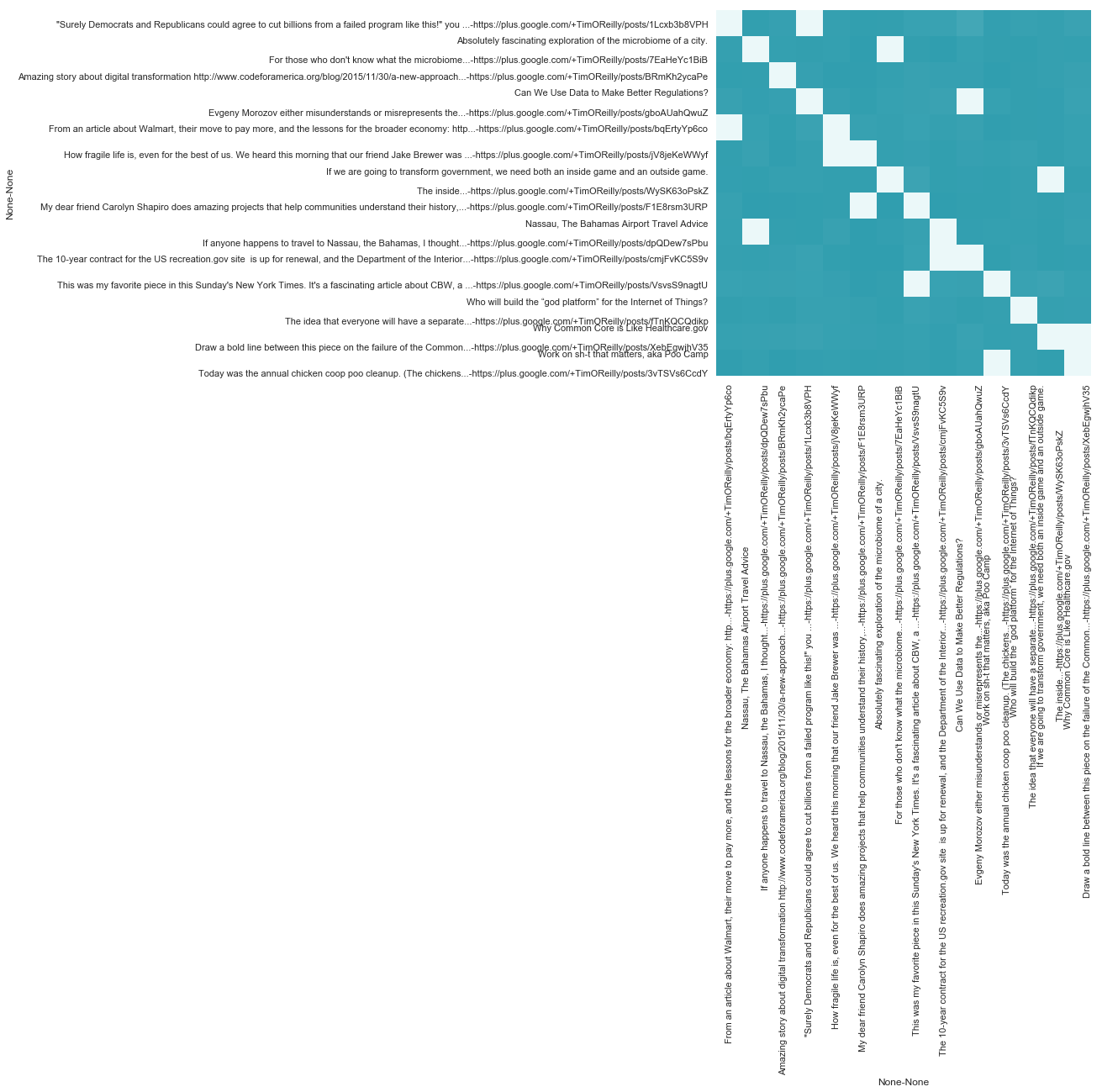
Clustering Hiérarchique#
import scipy.spatial as sp, scipy.cluster.hierarchy as hc
df = p.DataFrame(distances)
for i in range(len(df)):
df.iloc[i,i] = 0
La matrice doit être symmétrique.
mat = df.values
mat = (mat + mat.T) / 2
dist = sp.distance.squareform(mat)
from pkg_resources import parse_version
import scipy
if parse_version(scipy.__version__) <= parse_version('0.17.1'):
# Il peut y avoir quelques soucis avec la méthode Ward
data_link = hc.linkage(dist, method='single')
else:
data_link = hc.linkage(dist, method='ward')
fig = plt.figure( figsize=(8,8) )
g = sns.clustermap(df, row_linkage=data_link, col_linkage=data_link)
# instance de l'objet axes, c'est un peu caché :)
ax = g.ax_heatmap
ax;
<Figure size 576x576 with 0 Axes>
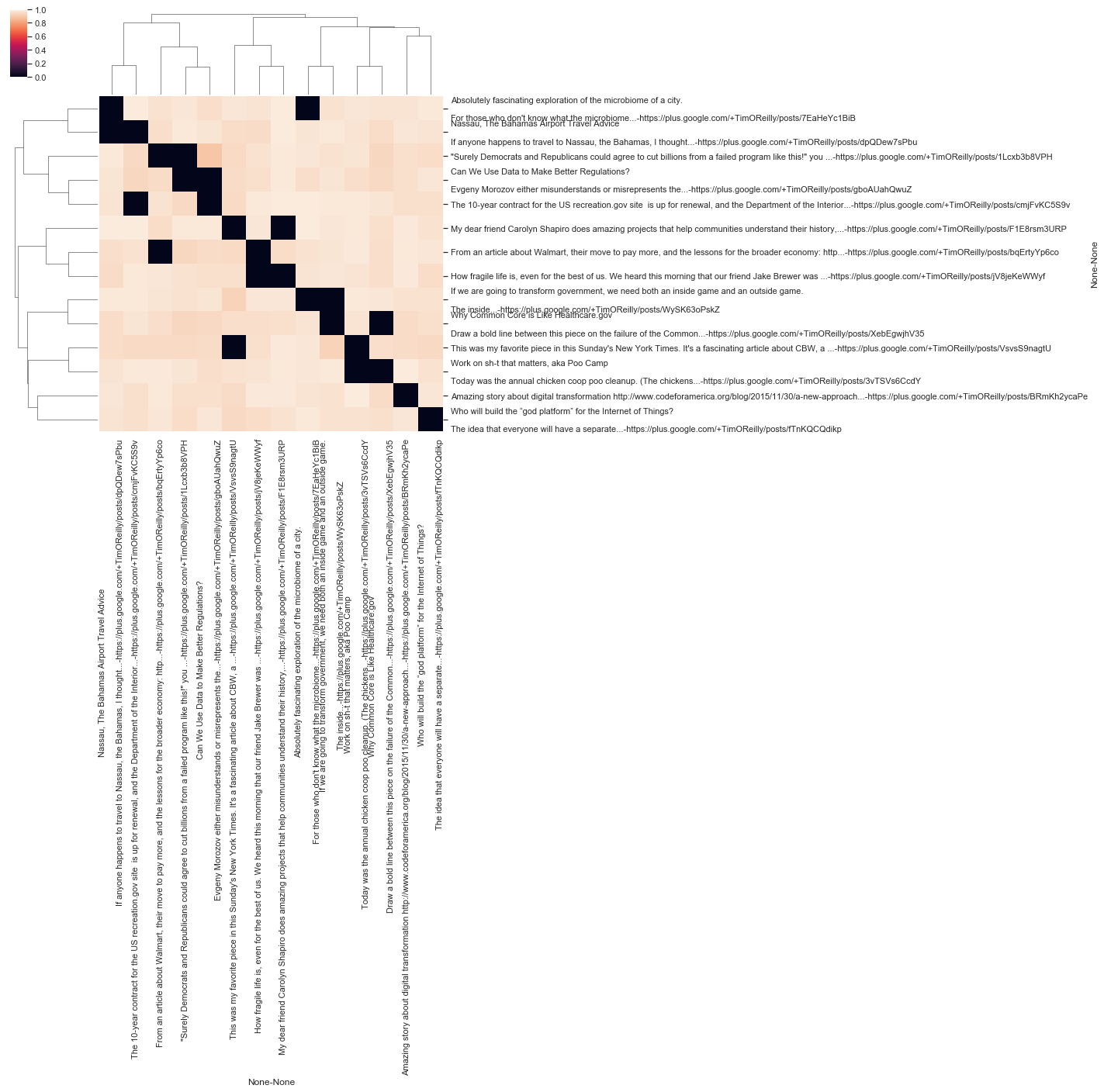
On voit que les documents sont globalement assez différents les uns des autres.
Exercice 5#
Comparaison des différentes fonctions de distances.
import json
import nltk
path = 'ressources_googleplus/107033731246200681024.json'
data = json.loads(open(path).read())
# Nombre de co-occurrences à trouver
N = 25
all_tokens = [token for activity in data for token in \
activity['object']['content'].lower().split()]
finder = nltk.BigramCollocationFinder.from_words(all_tokens)
finder.apply_freq_filter(2)
#filtre des mots trop fréquents
finder.apply_word_filter(lambda w: w in nltk.corpus.stopwords.words('english'))
bim = nltk.collocations.BigramAssocMeasures()
distances_func = [bim.raw_freq, bim.jaccard, bim.dice, bim.student_t, \
bim.chi_sq, bim.likelihood_ratio, bim.pmi]
collocations = {}
collocations_sets = {}
for d in distances_func:
collocations[d] = finder.nbest(d,N)
collocations_sets[d] = set([' '.join(c) for c in collocations[d]])
print('\n')
print(d)
for collocation in collocations[d]:
c = ' '.join(collocation)
print(c)
<function NgramAssocMeasures.raw_freq at 0x000001AB1D070EA0>
o'reilly media
new york
next:economy summit
open data
silicon valley
+jennifer pahlka
common core
data science
real businesses
really great
well worth
bay mini
brett goldstein
cabo pulmo
child welfare
credit card
east bay
government services
granite workers
humble bundle
i'm proud
maker faire
mini maker
never search
next:economy summit.
<bound method NgramAssocMeasures.jaccard of <class 'nltk.metrics.association.BigramAssocMeasures'>>
bottom, “copyright
brett goldstein
cabo pulmo
nbc press:here
nick hanauer
press:here tv
wood fired
yuval noah
silicon valley
+jennifer pahlka
barre historical
computational biologist
mikey dickerson
saul griffith
bay mini
child welfare
credit card
east bay
on-demand economy,
white house
drm-free ebooks
humble bundle
inca trail
italian granite
private sector
<function BigramAssocMeasures.dice at 0x000001AB1D078620>
bottom, “copyright
brett goldstein
cabo pulmo
nbc press:here
nick hanauer
press:here tv
wood fired
yuval noah
silicon valley
+jennifer pahlka
barre historical
computational biologist
mikey dickerson
saul griffith
bay mini
child welfare
credit card
east bay
on-demand economy,
white house
drm-free ebooks
humble bundle
inca trail
italian granite
private sector
<bound method NgramAssocMeasures.student_t of <class 'nltk.metrics.association.BigramAssocMeasures'>>
o'reilly media
silicon valley
next:economy summit
new york
open data
+jennifer pahlka
common core
well worth
real businesses
data science
really great
brett goldstein
cabo pulmo
bay mini
child welfare
east bay
white house
credit card
on-demand economy,
humble bundle
maker faire
mini maker
granite workers
worth reading.
next:economy summit.
<bound method BigramAssocMeasures.chi_sq of <class 'nltk.metrics.association.BigramAssocMeasures'>>
bottom, “copyright
brett goldstein
cabo pulmo
nbc press:here
nick hanauer
press:here tv
wood fired
yuval noah
silicon valley
barre historical
computational biologist
mikey dickerson
saul griffith
+jennifer pahlka
bay mini
child welfare
east bay
white house
credit card
on-demand economy,
drm-free ebooks
weeks ago,
humble bundle
inca trail
italian granite
<bound method NgramAssocMeasures.likelihood_ratio of <class 'nltk.metrics.association.BigramAssocMeasures'>>
silicon valley
+jennifer pahlka
o'reilly media
next:economy summit
common core
new york
brett goldstein
cabo pulmo
well worth
bay mini
child welfare
east bay
white house
credit card
on-demand economy,
maker faire
mini maker
granite workers
open data
humble bundle
worth reading.
real businesses
next:economy summit.
bottom, “copyright
nbc press:here
<bound method NgramAssocMeasures.pmi of <class 'nltk.metrics.association.BigramAssocMeasures'>>
bottom, “copyright
nbc press:here
nick hanauer
press:here tv
wood fired
yuval noah
barre historical
brett goldstein
cabo pulmo
computational biologist
mikey dickerson
saul griffith
drm-free ebooks
weeks ago,
inca trail
italian granite
private sector
value maximization
+bryce roberts
autonomous vehicles
bay mini
bryce roberts
child welfare
east bay
income inequality.
Pour comparer les sets deux à deux, on peut calculer de nouveau une distance de jaccard… des sets de collocations.
for d1 in distances_func:
for d2 in distances_func:
if d1 != d2:
jac = len(collocations_sets[d1].intersection(collocations_sets[d2])) / \
len(collocations_sets[d1].union(collocations_sets[d2]))
if jac > 0.8:
print('Méthode de distances comparables')
print(jac,'\n'+str(d1),'\n'+str(d2))
print('\n')
print('\n')
print('\n')
for d1 in distances_func:
for d2 in distances_func:
if d1 != d2:
jac = len(collocations_sets[d1].intersection(collocations_sets[d2])) / \
len(collocations_sets[d1].union(collocations_sets[d2]))
if jac < 0.2:
print('Méthode de distances avec des résultats très différents')
print(jac,'\n'+str(d1),'\n'+str(d2))
print('\n')
Méthode de distances comparables
1.0
<bound method NgramAssocMeasures.jaccard of <class 'nltk.metrics.association.BigramAssocMeasures'>>
<function BigramAssocMeasures.dice at 0x000001AB1D078620>
Méthode de distances comparables
0.9230769230769231
<bound method NgramAssocMeasures.jaccard of <class 'nltk.metrics.association.BigramAssocMeasures'>>
<bound method BigramAssocMeasures.chi_sq of <class 'nltk.metrics.association.BigramAssocMeasures'>>
Méthode de distances comparables
1.0
<function BigramAssocMeasures.dice at 0x000001AB1D078620>
<bound method NgramAssocMeasures.jaccard of <class 'nltk.metrics.association.BigramAssocMeasures'>>
Méthode de distances comparables
0.9230769230769231
<function BigramAssocMeasures.dice at 0x000001AB1D078620>
<bound method BigramAssocMeasures.chi_sq of <class 'nltk.metrics.association.BigramAssocMeasures'>>
Méthode de distances comparables
0.8518518518518519
<bound method NgramAssocMeasures.student_t of <class 'nltk.metrics.association.BigramAssocMeasures'>>
<bound method NgramAssocMeasures.likelihood_ratio of <class 'nltk.metrics.association.BigramAssocMeasures'>>
Méthode de distances comparables
0.9230769230769231
<bound method BigramAssocMeasures.chi_sq of <class 'nltk.metrics.association.BigramAssocMeasures'>>
<bound method NgramAssocMeasures.jaccard of <class 'nltk.metrics.association.BigramAssocMeasures'>>
Méthode de distances comparables
0.9230769230769231
<bound method BigramAssocMeasures.chi_sq of <class 'nltk.metrics.association.BigramAssocMeasures'>>
<function BigramAssocMeasures.dice at 0x000001AB1D078620>
Méthode de distances comparables
0.8518518518518519
<bound method NgramAssocMeasures.likelihood_ratio of <class 'nltk.metrics.association.BigramAssocMeasures'>>
<bound method NgramAssocMeasures.student_t of <class 'nltk.metrics.association.BigramAssocMeasures'>>
Méthode de distances avec des résultats très différents
0.1111111111111111
<function NgramAssocMeasures.raw_freq at 0x000001AB1D070EA0>
<bound method NgramAssocMeasures.pmi of <class 'nltk.metrics.association.BigramAssocMeasures'>>
Méthode de distances avec des résultats très différents
0.1111111111111111
<bound method NgramAssocMeasures.student_t of <class 'nltk.metrics.association.BigramAssocMeasures'>>
<bound method NgramAssocMeasures.pmi of <class 'nltk.metrics.association.BigramAssocMeasures'>>
Méthode de distances avec des résultats très différents
0.16279069767441862
<bound method NgramAssocMeasures.likelihood_ratio of <class 'nltk.metrics.association.BigramAssocMeasures'>>
<bound method NgramAssocMeasures.pmi of <class 'nltk.metrics.association.BigramAssocMeasures'>>
Méthode de distances avec des résultats très différents
0.1111111111111111
<bound method NgramAssocMeasures.pmi of <class 'nltk.metrics.association.BigramAssocMeasures'>>
<function NgramAssocMeasures.raw_freq at 0x000001AB1D070EA0>
Méthode de distances avec des résultats très différents
0.1111111111111111
<bound method NgramAssocMeasures.pmi of <class 'nltk.metrics.association.BigramAssocMeasures'>>
<bound method NgramAssocMeasures.student_t of <class 'nltk.metrics.association.BigramAssocMeasures'>>
Méthode de distances avec des résultats très différents
0.16279069767441862
<bound method NgramAssocMeasures.pmi of <class 'nltk.metrics.association.BigramAssocMeasures'>>
<bound method NgramAssocMeasures.likelihood_ratio of <class 'nltk.metrics.association.BigramAssocMeasures'>>
import json
import nltk
path = 'ressources_googleplus/107033731246200681024.json'
data = json.loads(open(path).read())
# Nombre de co-occurrences à trouver
N = 25
all_tokens = [token for activity in data for token in \
activity['object']['content'].lower().split()]
finder = nltk.TrigramCollocationFinder.from_words(all_tokens)
finder.apply_freq_filter(2)
#filtre des mots trop fréquents
finder.apply_word_filter(lambda w: w in nltk.corpus.stopwords.words('english'))
trigram_measures = nltk.collocations.TrigramAssocMeasures()
collocations = finder.nbest(trigram_measures.jaccard, N)
for collocation in collocations:
c = ' '.join(collocation)
print(c)
nbc press:here tv
east bay mini
cabo pulmo sunrise
bay mini maker
barre historical society
mini maker faire
press:here tv interview
well worth reading.
child welfare system
italian granite workers
open source software
abc world news
i'm super excited
new york times.
real businesses make